Q. What is Bandhani?
The word Bandhani/ Bandhni comes from the Hindi/ Sanskrit words ‘Bandhna’ and ‘Bandha’, meaning ‘tying’ or ‘to tie’. Bandhej is a variation of this word. Bandhani refers to the traditional Indian ‘tie and dye‘ art (resist-dyeing technique that uses impermeable threads for tying), used to produce beautiful, fine circular patterns on fabrics.
Q. How old is the technique?
Bandhani is an ancient art. Earliest references to this technique of picking the cloth with finger-nails and tying, before dyeing, are found in Indus Valley Civilization records, dating back to 4000 B.C. Even the Buddhist paintings, dating back to the 6th Century, in the famous Ajanata Caves have Bandhani references. Texts dating back to the times of Alexander – the great also extolled Indian Bandhani.
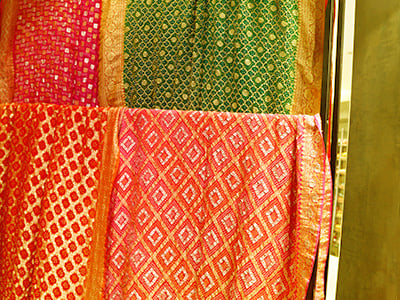
Q. Bandhani and other Tie and Dye methodologies…
Tie and Dye methodology, in various forms, is used frequently in the textile design industry, on fabrics, t-shirts, bandanas, scarves and dresses. In the West, this became a rage in late 60s, and is associated with the Bohemian and Hipster cultures. African Tie and Dye techniques are also well known.
In South East Asia, tie and dye assumes the stature of an art-form. Done by hand, through intricate, skill-intensive processes, these techniques are rooted in local cultures. In Japan, traditional tie and dye is called as Shibori (seen on Japanese Kimonos), while in Malay-Indonesia, Plangiand Tritikare popular tie and dye versions. These arts make use of intricate stitching (to create resistance), followed by dyeing. In Thailand, the popular Mudmee technique is used to create Shibori-like tie and dye patterns on unique black base.
Bandhanis the Indian version of ‘tie and dye’. The patterns formed in Bandhani are way finer. It typically works with small circular patterns – the ‘dots’ or ‘specks’ motifs, created using skilled tying - using fingernails, iron-nails etc. The distinctive Bandhani dots are used to create various designs, ranging from floral to animal patterns. Sometimes, small squares or other variations are created too. Lehariya or leheria is another popular Indian tie and dye technique, used to create ‘lehar’ or wave patterns. Practised avidly in Rajasthan, it is used to create vibrant turbans, sarees and dupattas.
Q. Who produces Bandhani?
Bandhani is an Indian hand-done textiles-art/ craft, generally carried out by skilled Bandhani artisans, dyers and workers as well as experienced families involved traditionally in the craft. Many women and young girls in Bandhani centres tie fabrics, sometimes pre-traced with designs, to create bandhani. These are, then, dyed, re-tied and re-dyed by the men-folk of the family. Bandhani is a major textiles-craft industry, though it is still small in scale and relies heavily on time-consuming, traditional techniques and processes.
Q. What is Bandhani used for?
Bandhani is used to create attractive, unique patterns and designs on fabrics. Women in rural areas earlier used simple Bandhej techniques to give special vibrance to their modest clothes. Today, finished Bandhani products are much in demand in the apparel industry. Sarees, ghagras, dress materials, dupattas, shawls, turbans and even western silhouettes are created using the fabric crafted with Bandhej. It is also used in bed linen, curtains and upholstery.
Q. What are the cultural connects of Bandhani?
Bandhani is considered very auspicious, especially in Rajasthan and Gujarat. From weddings to births, Bandhani finds a sacred association everywhere. Legends have it that wearing Bandhani Sarees invites good luck. There was a time when all brides in Western India wore Wedding Sarees or Bridal Lehenga Cholis decorated with fine Bandhani. The Gujarati Gharchola (the Bridal Saree gifted from groom’s family) and Panetar (Gujarati Wedding Ensemble) have delicate Bandhani work. In Rajasthan, the varying Bandhani patterns and colours of the turbans worn by menfolk indicate their castes and communities. Bandhani is also used to convey life stages. While red represents marriage, yellow signifies motherhood and green signifies fertility.
Q. Where is Bandhani, generally,practised?
Bandhani has been culturally associated with the West-Indian states of Gujarat and Rajasthan. Patterns and motifs used in Gujarati and Rajasthani Bandhej are quite sought after. Finer the Bandhani, steeper the price!
Delicate Bandhej is made in Gujarat’s Kutch belt, especially Mandvi. Families in Mandavi, Anjar, Jamnagar, Bhuj have been employed in Bandhani trade, since centuries. The Kutchi Bandhej, also made in the entire Saurashtra belt, is relatively coarser. Simpler Bandhani patterns are tied in other areas of Gujarat, including Ahmedabad, Deesa, Morbi, Porbandar and Rajkot and Surendranagar district. Jamnagar is popular for dyeing Bandhej fabrics, especially if colour is from the red-palette, as the water quality of this region is believed to lend amazing brightness to the reds.
In Rajasthan, the finest Bandhani is tied in the desert town of Bikaner, and in Sikar district. Entire Jaipur belt also produces Bandhani. Apart from this, most cities of Rajasthan have their own Bandhani centres. Bagru, Block printing and Leheriya are other hand textile crafts popularly practised in Rajasthan.
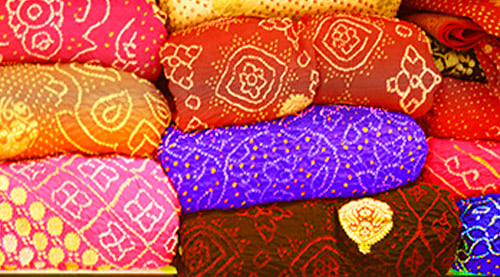
Q. Are there any variations to Indian Bandhani?
Madhya Pradesh and Punjab also produce Bandhani. The patterns employed are thicker and bigger. The tying methods differ, and may be done using kidney-beans, pebbles, coins etc.
Notably, in the erstwhile province of Sindh, now in Pakistan, a certain style of coarser Bandhani is quite popular. Sindhi community across India and Pakistan uses this Bandhej. The Sindhi Bandhani was revived in Pakistan’s port city Karachi, primarily by Khatri immigrants from Kutch (Gujarat). Block Printing technique of Kutch’s Ajrakh, though created differently,is also culturally associated to Sindhi Bandhani.
Another lesser known variation of the tie-dye is practised in the Southern state of Tamil Nadu. Brought to the towns of Madurai and Chinnalapatti by Sourashtrian Gujaratis centuries ago, Sungudi (the Southern Bandhini) also works around the typical ‘dots’ motifs. However, the fading art of Sungudi, as used in light-weight, cotton Sungudi Sarees, needs revival. The sarees are expensive, and the process is labour intensive, owing to which this industry has been facing survival issues.
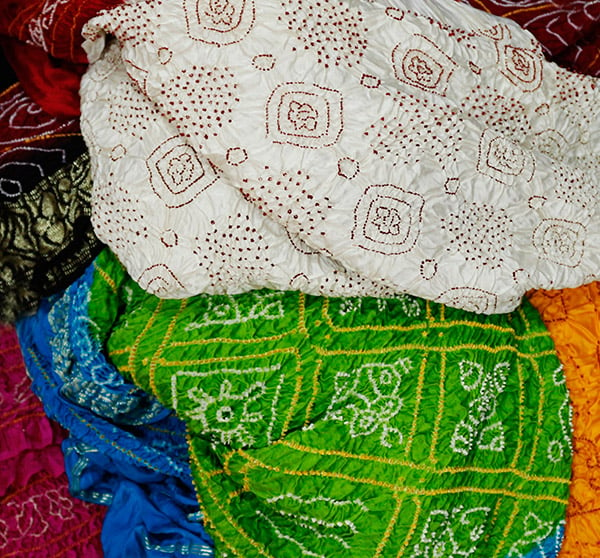
Q. What materials are used to create Bandhani?
Artisans usually start with white, unbleached fabric. Thick cords are used to cast designs, using Geru mixture (red/ orange earth mixed with water). These days, design stencils made of stiff plastic sheet are also used. Bandhani is tied using thick, impermeable cotton strings. Dyes, many of them natural and eco-friendly, of various kinds are used in Bandhani. Big utensils are used to create dye solutions.
Q. Which Dyes are used in Bandhani?
Bandhani is crafted using a hand technique, hence the used of heavy-duty industrial dyes and dye-stuffs is limited or absent. Initially, Bandhej was done using only natural dyes like Indigo or colours extracted from plant roots, vegetables, flowers and leaves. With time, man-made chemical dyes were introduced in Bandhani making. These dyes give vibrant colours, and are faster. Most Bandhani fabrics, nonetheless, lose colour on washing, as there is a good amount of re-dyeing involved. Today, a just mix of natural and synthetic dyes is used to dye Bandhanis.
Q. What kind of base is needed for Bandhani?
Bandhani needs a resilient base, as the fabric is subjected to intricate tying and multiple rounds of dyeing. This fabric must also be able to withstand the stretching, while opening/ unraveling knots. The base fabric must also be absorbent, so as to satisfactorily absorb colours, during the hand-dyeing process.
Q. Which fabrics are used in Bandhani?
Traditionally, fine mill-made cottons or muslins were used to create Bandhani. The contemporary artisans, given the changing preferences, also work on fine georgettes, art silks, silk-cotton blends, viscose and cotton variants. Pure Venkatigiri cotton, sourced from Andhra Pradesh, is used to create traditional Gharcholas. Georgettes with pure Banarasi brocade borders are used to make vibrant and colourful, high-end Jhankaar Bandhanis.
Q. Is Bandhani available in Silk?
Owing to a great demand, Bandhani is also done in Silk. However, pure silk, on its own, is fragile, and lacks the resilience intricate, tight tying and unraveling need. Silks run the risk of tearing. Delicate silk may also lose its texture, given the crushing and crinkling. Pure silk bandhanis, thus, are rare and expensive. Most silk fabrics used for Bandhanis are blended with cotton or viscose. Pure georgettes (made from silk fibers) are also extremely popular as base materials for crafting expensive Bandhani.
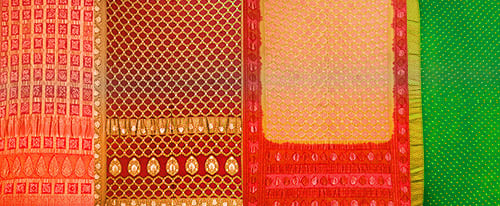
Q. What are Gaji Silk Bandhani Sarees?
Silk’s lustre and beauty are quite sought, more so in Bandhani sarees, as they are closely associated with auspicious occasions. Since pure silk lacks the tensile strength required for the Bandhani process, fabrics are fortified with poly fibers, cottons etc. The resulting blends are more agile and less expensive. One such poly-silk blend, used avidly to craft Bridal Bandhanis, is Gaji Silk. This base material is thicker, lustrous and smooth, can be dyed in vibrant colours and is strong enough to withstand heavy embellishments like Zari borders, Zardozi embroidery etc. Gujarati Gharcholas, Panetars and Bandhani Wedding Lehenga Cholis are also crafted in gaji silk.
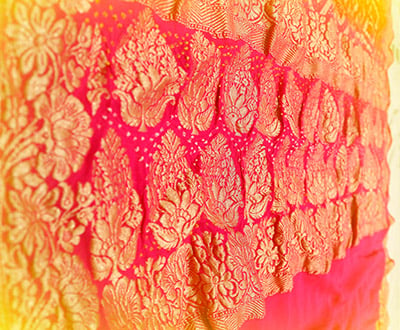
Q.What are Banarasi Bandhani Sarees?
Bandhani sarees with Banarasi brocade borders are called as Banarasi Bandhanis. They generally are made using pure, high quality georgette fabric that is adorned with brocade and Banrasi weave borders. Bandhani done on these expensive sarees is often extremely fine.
Q. Which colours are popularly used in Bandhani?
Bandhani is a vibrant craft, associated with auspiciousness. It makes use of dark, deep tones, but usually begins with lighter hues. The first dyeing is generally done in yellow. White and yellow often appear in the circular patterns. Reds, maroon, ochre, tangerine, indigo blues, turquoise blue, deep greens are traditional Bandhani colours. These days, we may also find colours like purple, mustard yellow, beige, pink and even black.
Q. Types of Bandhani Patterns?
A single Bandhani dot is called as Ek Dali or Bundi, four are called as Chaubundi and seven are called as Satbundi. Small dots with darker centres are called as Boond, while tear-drop shaped dots are called as Kodi. Patterns or circles appearing in clusters of three are called as Trikunti, while groups of four are called as Chaubasi, and seven are called as Satbandi. Elaborate motifs and designs of leaves, flowers, trees, human figurines are made, by repeating Bandhani dots and patterns. Dungar Shahi (mountain pattern), Laddu Jalebi (Indian sweetmeats) and Leheriya (waves) are other popular Bandhani patterns.
Q. Types of Bandhani Sarees?
Jhankaar Bandhani – Bandhani type that is very colourful and vibrant, and has extremely fine, patterns. Jhankaar Bandhani doesn’t have light or white coloured dots, present in other Bandhani styles. For example an all green Jhankaar Bandhani will have red or maroon dots.
BorJaal – Used mostly for Wedding Bandhani Sarees. This highly intricate and fuller Bandhani, as the name suggests (jaal or web), is quite popular among Marwari communities. Sarees with BorJaal Bandhani have a striking inter-play of colours and dots, creating an amazing maze. They are available in many colours, and are also made in georgettes.
Colour Discharge Bandhani – Typically, Bandhani is created by using darker colours over lighter ones. However, in the colour discharge technique, this effect is reversed - lighter colours are visible over darker coloured dot patterns. In such a Bandhej, you will see deep red dots on a pale yellow base. Striking! This is achieved by discharging darker hues.
Q. How should Bandhani Sarees be maintained?
Maintaining Bandhani sarees (and all fabrics with Bandhani) is very important, as it is a delicate craft that can lose colour and vibrance, owing to neglect. Bandhani sarees are carefully roll-pressed and finished, before they are sold. Similar process needs to be followed by the wearer, before every wear. Use only steam iron to iron these sarees. Each Bandhani saree must ONLY be DRY CLEANED (petrol washed), or it will lose its colour. A good quality saree fall must be attached to this saree, as these are delicate sarees.
Bandhani in Bollywood
Flying Bandhani dupattas with all their vivid detail and colour, standing out strikingly amidst paler backdrops have been used, ever since the advent of coloured films, by the Bollywood film-makers - to convey various emotions.
The Hindi film industry as well as the Indian television industry has played an important role in popularizing Bandhani craft, across India and the world. Gujarati serials, films and movies with Rajasthani/ Gujarati background have also effectively showcased Bandhej craft.
Since this is a vibrant craft, Bandhani finished products lend an amazing brightness on-screen. Bandhani sarees look spectacular, and cinematic nuances of cameras can pick splendid details of this lovely art. Celebrities, both Indian and international, have been spotted flaunting Bandhani.

